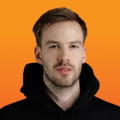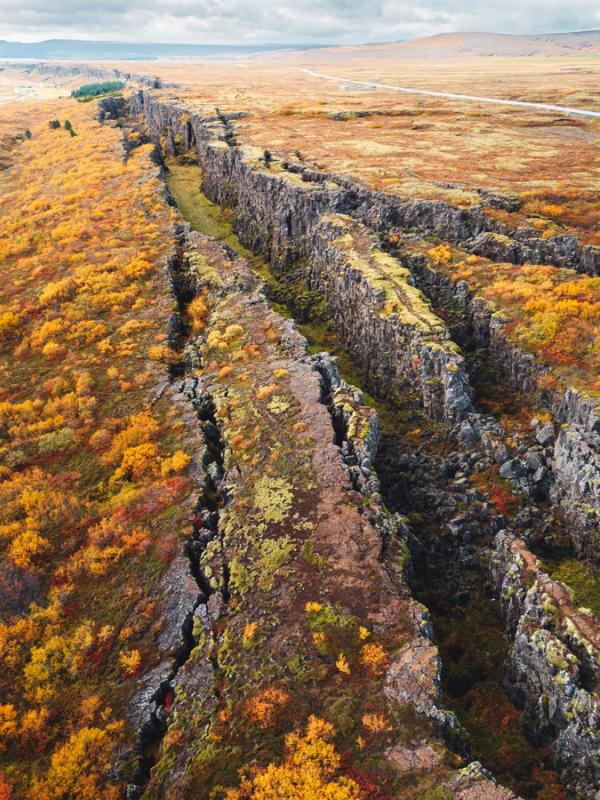
Discovering Þingvellir National Park: The Gem of Iceland
Iceland has a rich cultural, historical, and artistic life. Still, what draws more visitors to this Nordic country is its astonishing landscapes, impressive volcanoes, overwhelming glaciers, and picturesque waterfalls.
In this guide, we will take you to the perhaps most famous of them all: Þingvellir National Park. This park is the jewel of Iceland. A unique place that blends natural beauty, rich history, and unique geological features. It also contains some of Iceland’s most visited features and natural monuments.
If you are planning to visit Iceland, Þingvellir National Park should definitely be on your list. Let’s go!
Key Takeaways
- Iceland has three national parks: Þingvellir National Park, Vatnajökull National Park and Snæfellsjökull National Park.
- Þingvellir -that can also be spelt Thingvellir- is a UNESCO World Heritage Site, which makes it unique.
- The park is located in the southwest of the country, just 40 kilometers (25 miles) away from Reykjavik.
- Þingvellir is part of the famous Golden Circle, a driving route that takes you to some of the best things to see in Iceland.
Why is Þingvellir National Park Worth a Visit?
Not many places in Iceland have such a rich mix of nature, culture, and history as Þingvellir National Park. In fact, if something sets Þingvellir apart from the other national parks and natural reserves in the country, it is its historical importance.
This is where the world's first parliament, the Alþingi—or Althing-, was established in 930. The gatherings here occurred annually until 1798 and shaped the nation's identity. It’s impressive to walk where the parliament used to stand and feel the weight of history on your shoulders.
But history isn't the only draw. Geologically, Þingvellir is a unique spot where the North American and Eurasian tectonic plates meet. This phenomenon creates stunning landscapes with fissures, valleys, and clear glacial waters. And not just that, you can touch both plates simultaneously. But we’ll get into that later when we explain the Silfra Fissure.
The park also has a rich cultural heritage, as it was here that Icelanders made the historic decision to convert to Christianity in the year 1000.
Recently released data from the Icelandic government revealed that the historical path of Kárastaðastígur within Thingvellir was the third most-visited spot in Iceland in 2024, with 675,558 visitors. That many people can’t be wrong!

What to See in Þingvellir National Park
There’s a lot to see and do here. For this reason, even if Þingvellir is close to Reykjavik and well-connected, plan your trip carefully to make the most of your visit. Because we are quite sure you won’t want to miss anything about this incredible place.
Silfra Fissure
It’s really difficult to highlight just one thing in Þingvellir National Park. Everything here is worth a visit. But there’s no doubt that one of the best-known and most impressive features in the park is the Silfra Fissure. A place that is unique in the world.
Iceland is located where the North American and Eurasian tectonic plates meet, meaning the country is technically on two continents. Silfra is where this can be seen. Here, you can swim between the continental plates in crystal-clear water with visibility up to 100 meters. The water is so clear because it comes from the Langjökull glacier and is then filtered through lava rocks.
Even if the climate in Iceland isn’t inviting for swimming, if you rent the appropriate gear, you’ll be comfortable inside the fissure. And don’t even think about not using a drysuit, as the water temperature inside the fissure is between 2 and 4 °C (35.5 to 39 °F) all year round.
The best part of swimming here is you can touch both tectonic plates simultaneously. However, that will become more difficult in the future because of the divergent movement of the tectonic plates. They are moving and drifting apart at about 2 centimeters per year.
Silfra is divided into four main sections, each offering a different experience:
- Silfra Big Crack: The narrowest part where you can touch both continental plates.
- Silfra Hall: A wider area with stunning rock formations and vivid blue water.
- Silfra Cathedral: The deepest section, offering stunning views.
- Silfra Lagoon: A shallow and quiet area perfect for relaxation and photography.
Snorkeling and diving in Silfra are much more than just the feeling of swimming between continents. The underwater landscape is stunning. Here, you’ll see lava formations, algae, and a play of light that creates a magical atmosphere. The water is so clear here that you feel like flying over the bottom of the fissure.

Almannagjá Gorge
One of the most iconic sights in Þingvellir National Park is the Almannagjá Gorge. It’s the above-the-surface equivalent of the Silfra Fissure: a dramatic rift valley formed by the separation of the tectonic plates.
Here you can walk between cliffs, contemplating the raw forces that shape our planet. The gorge also has historical significance, as it was the original site of the Lögberg, where the Althing would gather.
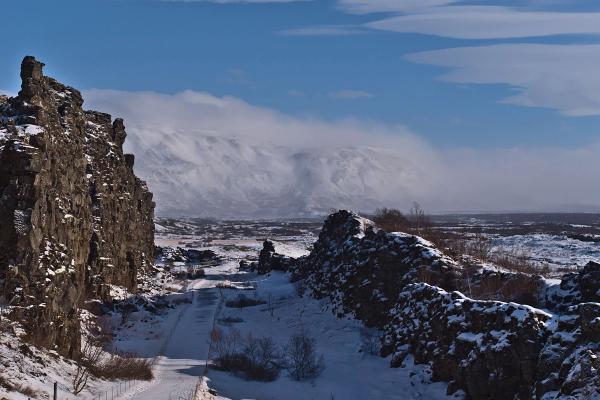
Öxarárfoss Waterfall
Not far from the Almannagjá Gorge, you can find this beautiful cascade. Iceland has many iconic waterfalls, and this is the best you can see in Þingvellir. Öxarárfoss is not particularly big compared to others in the country but is not short of beauty.
The waterfall flows into the Öxará River, forming a rocky pool below. It’s a great place to take a break and observe the park's beauty. It’s also a relatively easy hike from the visitor center. In winter, the waterfall is surrounded by snow and ice, creating a magical effect.
Öxarárfoss was artificially created in the Middle Ages to provide water for the assembly at Þingvellir, adding another layer of historical interest to its natural beauty.
Þingvallavatn Lake
In the heart of Þingvellir National Park, you can find Þingvallavatn Lake, Iceland’s largest natural lake. It covers an area of 84 square kilometers and a maximum depth of 114 meters (375 feet). This large body of water is a geological wonder with a rich and important ecosystem.
The lake's clear waters are home to various fish species, including the Arctic char and the brown trout. Bird watchers can enjoy sightings of species such as the great northern diver and the harlequin duck. The lake itself plays a crucial role in maintaining the region's biodiversity.
This is the perfect place to take a break from your excursion. The surrounding area is full of beautiful landscapes, perfect for hiking or, if the weather is good, a great spot to have a picnic.
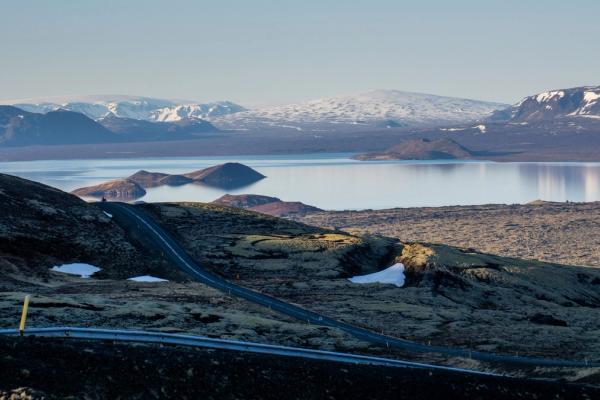
Þingvallakirkja (Þingvellir Church) and Farmhouses
These are remnants of the people who once lived here. The beautiful church dates back to the 11th Century, adding a touch of history to this part of the park. The current building was built in 1859 over the remains of another one.
In the surrounding farmhouses, you’ll see traditional Icelandic civil architecture reflecting Iceland's pastoral tradition.

Drekkingarhylur
This is a deep pool in the Öxará River with a dark history attached to it. Drekkingarhylur, which translates to Drowning Pool, is a place where, in the past, women convicted of infanticide or incest were executed.
Despite this terrible past, Drekkingarhylur is a gorgeous spot where you can take great photos.

What to Do in Þingvellir National Park
There are many ways to explore the park, whether on the surface or below the water.
Hiking
Hiking is the most popular way to discover all the marvels Þingvellir National Park offers. Many hiking trails here have a wide range of difficulty levels and lengths, from easy walks through Almannagjá Gorge to more rugged trails exploring less-visited areas of the park.
One of the most popular trails here is the walk from the visitor center to Öxarárfoss waterfall. This trail is well-maintained and relatively flat, which makes it accessible for everyone. Along the way, you'll pass through Almannagjá Gorge, so you’ll visit two of the best spots in the park while having a comfortable walk. Also, the trails that surround Þingvallavatn Lake have fantastic views.
There are more challenging and longer trails leading to other parts of the park that are less accessible and less visited. You can get information in the visitor center if you want to get to deeper parts.
Snorkeling and Diving
As mentioned earlier, Silfra Fissure is one of the best places in the world for snorkeling and diving. The experience of floating in the clear, cold waters between two tectonic plates is truly unique. Just make sure to book in advance and ensure you have the necessary certifications for diving.
Exploring Historical Sites
Take your time to explore the historical sites found here in the park. From the Alþingi assembly site to ancient farm ruins, these locations offer a look into Iceland's past and the early days of its settlement.
The Alþingi site is particularly fascinating, as it was where the country's leaders gathered to make laws and settle disputes.
Camping
Camping is a fantastic way to immerse yourself entirely in the park. Several designated camping areas inside the park allow you to spend the night in such a magical place. The main campground, Leirar, is located near the visitor center and offers basic facilities such as toilets and running water.
If you are going to camp here, respect your surroundings. Collect your trash, don’t go into areas you don’t know, don’t interact with the wildlife, and don’t create loud and unnecessary noises.
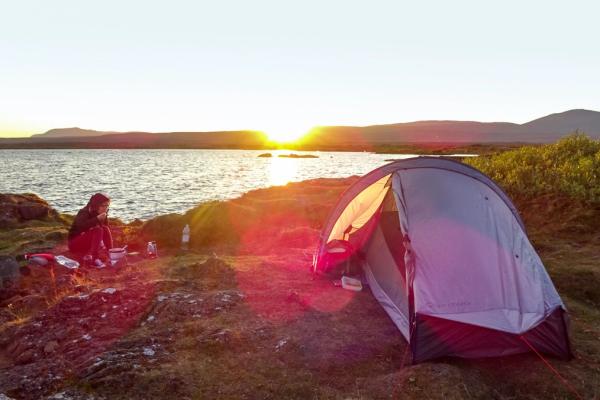
Horseback Riding
Iceland's most famous endemic animal is, by far, the Icelandic horse. These beautiful and small but powerful creatures are a great companion to discover the corners of Þingvellir. They are also a great photo opportunity.
Many have been domesticated, and tours are available to see the park while riding one of these majestic animals.

Photography
The whole country is like a large studio set. Everywhere you go, you’ll encounter something worth photographing. And, with its dramatic landscapes and historical landmarks, Þingvellir is a paradise for photographers.
The park offers countless opportunities for stunning shots. Whether you're a professional photographer or just love taking pictures, you'll find plenty of inspiration here.
Wildlife Watching
Þingvellir is home to a variety of wildlife, including Arctic foxes, mink, and a wide range of bird species. The park's diverse habitats, from its lakes and rivers to its forests and open plains, provide ample opportunities for wildlife watching. Bring binoculars and keep your eyes peeled for some of the park's more elusive residents.
Where is Þingvellir National Park & How to Get there?
Þingvellir National Park is located about 45 kilometers northeast of Reykjavík, making it an easy day trip from the capital. The drive takes less than an hour, and the route is very easy to follow. Another option for visiting the park is taking it as part of the famous Golden Circle, but we’ll get into that further down.
The best way to arrive at Þingvellir, taking Reykjavik as the starting point, is to take Route 36. Once on that road, the drive is pretty straightforward, and the signs make it almost impossible to get lost. Also, along the way, you’ll enjoy some of the famous magnificent landscapes this country has.
The park has several parking areas, with the main one near the visitor center.
The Golden Circle
The Golden Circle is one of the best ways to discover some of the best things to see in southwest Iceland. It’s a scenic loop that goes through some of the most visited landmarks in the country: Þingvellir National Park, the Geysir geothermal area, Gullfoss, the Secret Lagoon, and Bruarfoss, among others. It covers approximately 300 kilometers (185 miles) and is easily accessible from Reykjavik.
While Þingvellir, Geysir, and Gullfoss are the main attractions, the Golden Circle offers several exciting stops. For instance, the Kerið volcanic crater, with its striking blue-green lake, is a fascinating geological site.
The entire route can be comfortably covered in a day, but it is highly recommended that you take your time to explore each site fully, as the Golden Circle includes some of the best Iceland has to offer
What’s the weather like in Þingvellir National Park?
That’s a great question. Trying to decipher the weather, not only in this park but in Iceland in general, is a challenge. Although the country is far up north, it’s not as cold as other places in similar latitudes. But it’s not warm either.
The weather can be quite variable and changes rapidly, so it's essential to be prepared for a range of conditions. Þingvellir is located in southwestern Iceland, which can be warmer but also wetter and windier than the north.
Winter (November to March)
Winter in Þingvellir is cold, with temperatures often dropping below freezing. Daytime temperatures typically range from -1°C to 3°C (30°F to 37°F). Snow is common, creating a beautiful winter wonderland, but it can also make some trails slippery and challenging to navigate. Also, winter is the time of the year with the most chances to see the Northern Lights.
It’s important to know that snow can cause the authorities to close some roads, especially the infamous F Roads. Check the road conditions before starting your day.
Spring (April and May)
During these months, the temperature gets gradually warmer but is still quite chill. They usually range from 0°C to 10°C (32°F to 50°F). The molten snow can make the trails wet and muddy.
On the other hand, nature blooms in spring like no other time, and the fields come alive with colors and the passing of migratory birds. It’s still shoulder season, so the park shouldn’t be as crowded as in other moments.
Summer (June to August)
Summer is the most popular time to visit Þingvellir, thanks to milder temperatures and long daylight hours. Daytime temperatures typically range from 10°C to 15°C (50°F to 59°F), although they can occasionally reach 20°C (68°F).
At the end of June is when the Midnight Sun occurs, giving you 24 hours a day to explore the area. Summer is the best time of the year for hiking or diving in the Silfra Fissure.
Autumn (September and October)
Autumn brings cooler temperatures and more precipitation. Temperatures range from 0°C to 10°C (32°F to 50°F), and the weather can be even more unpredictable than usual. As the season passes by, the chances of snow increase.
The colors of nature are astonishing during this season, making it a beautiful time for photography and outdoor activities.
| Season | Temperatures |
| Winter (November to March) | -1°C to 3°C (30°F to 37°F) |
| Spring (April and May) | 0°C to 10°C (32°F to 50°F) |
| Summer (June to August) | 10°C to 15°C (50°F to 59°F) |
| Autumn (September and October) | 10°C to 15°C (50°F to 59°F) |
Travel Tips
- You can visit Þingvellir National Park on its own or as a part of a larger route, like the Golden Circle. Either way, the best way to get there is by car.
- The weather can be unpredictable and constantly changing. It can also affect the roads, so check the weather forecast and road conditions every morning before setting off for your destination.
- Every season shows a different side of Þingvellir, but it’s magnificent in all of them.
- Dressing in layers is the best way to combat the weather in Iceland. Always bring waterproof and windproof clothing and good hiking boots.
- Respect the environment. Þingvellir is a treasure not only for Iceland but for the world, and it’s our job that it keeps that way.
Conclusion
Not many places in Iceland offer so much on a relatively small surface as Þingvellir does. This national park has some of the best attractions in the country. Beautiful waterfalls, impressive landscapes, a place with great history, and the possibility of swimming between two continents.


